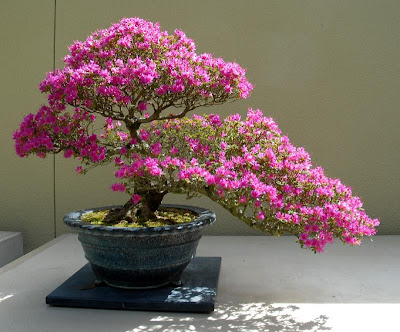Bonsai is an art form that stems from ancient, oriental culture, originating in China and developed by the Japanese. In the 13th century, the Japanese collected and potted wild trees that had been dwarfed by nature. These naturally formed miniatures were some of the first bonsai.
When demand for the small trees outgrew the supply, Japanese gardeners began to train bonsai from native trees. They shaped the trees to give them the illusion of age. The art of bonsai, as developed in America, is much freer in concept and style than Japanese bonsai.

Not all plants are equally effective as bonsai. To produce a realistic illusion of a mature tree, all parts of the ideal bonsai -- trunk, branches, twigs, leaves, flowers, fruits, buds, roots -- should be in perfect scale with the size of the tree. Plants used for bonsai should have small leaves or leaves that become small under bonsai culture. Plants with overly large leaves, such as the avocado, will look out of proportion if chosen for bonsai. Sycamores also develop leaves that are too large. Certain species of both maple and oak trees usually respond well to bonsai culture and develop leaves that are in proportion. Among the plants with small leaves and needles appropriate for bonsai are spruce, pine, zelkova, and pomegranate.

Plants chosen for bonsai should have attractive bark, and the trunk must give the illusion of maturity. The trunk should have girth, but must remain in proportion to the entire tree and should taper gradually toward the top of the tree. Sometimes, one or two of the main branches must be shortened to emphasize the vertical line of the trunk and give the trunk a balanced appearance.
To give the appearance of age, the upper one-third of the root structure of a mature bonsai is often exposed. Everywhere on the tree, but mostly from the front, the branches should look balanced and appear to be floating in space; they should not appear lopsided or top heavy. The branches should not be opposite one another with their lines cutting horizontally across the trunk. The branches give the bonsai dimension and establish the tree's basic form.
A bonsai should have a harmonious arrangement of branches without unsightly gaps. Flaws can be spotted by looking down on a bonsai. Upper branches should not overshadow lower branches.
Bonsai can be classified into five basic styles: formal upright, informal upright, slanting, cascade, and semicascade. These classifications are based on the overall shape of the tree and how much the trunk slants away from an imaginary vertical axis.
Bonsai Styles
| The formal upright style is considered the easiest for the novice bonsai grower. This style features a straight trunk and a bottom branch that is lower and extends farther from the trunk than the opposite branch. |
| The trunk in the informal upright style bends slightly to the front. This bend helps to give the style its look of informality. | |
| In the slanting style, the trunk has a more acute angle than in the informal upright style. The lowest branch spreads in a direction opposite to that in which the tree slants. |
| The cascade style of bonsai represents a natural tree growing down the face of an embankment. A cascaded planting usually looks best in a round or hexagonal container. | |
| The semicascade style has a curving trunk that does not reach the bottom of the container as in the cascade style. Prostrate junipers and flowering plants are well adapted to both of these styles. |
 |
| INFORMAL UPRIGHT STYLE |
 |
| SLANTING STYLE |
 |
| SLANTING STYLE |
 |
| CASCADE STYLE |
 |
| SEMICASCADE STYLE |
Bonsai Plant Guide
Trees and shrubs are suitable for traditional bonsai. Specialty nurseries often have a wide selection of dwarf and semidwarf varieties of many species. Dwarf plants, however, do not always convey the same impression as their full size counterparts because their growth habits are quite different. Some trees and shrubs that work well as bonsai are azalea, beech, boxwood, ginkgo, maple, oak, pine, wisteria, and zelkova.
AZALEA: Hiryu, Rhododendron obtusumIndica azalea, Rhododendron indicumKurume, Rhododendron obtusum
BEECH: American, Fagus grandifoliaEuropean, Fagus sylvatica
BIRCH: White, Betula papyrifera or B. pendula
BOXWOOD: Buxus species
FIRETHORN: Pyracantha species
GINKGO: Ginkgo biloba
HAWTHORN: English, Crataegus laevigata Washington, Crataegus phaenopyrum
IVY: English Ivy, Hedera helix and cultivars
MAPLE: Amur, Acer ginnala edge, Acer campestre Trident, Acer buergeranum
OAK: English, Quercus robur Pin, Quercus palustris Scarlet, Quercus coccinea White, Quercus alba
PINE: Bristlecone, Pinus aristata Japanese white, Pinus parviflora Japanese black, Pinus thunbergiana Mugo, Pinus Mugo Swiss stone, Pinus cembra White, Pinus strobus
WISTERIA: Japanese, Wisteria floribunda
YEW: Taxus species and cultivars
ZELKOVA: Japanese Zelkova, Zelkova serrata
American gardeners have taken bonsai concepts and applied them to house plants. By combining traditional procedures for handling house plants with bonsai concepts of design, growers have created different bonsai styles. The following woody plants (native to the tropics and subtropics of the world) have been grown as indoor bonsai. These plants can be obtained from either local or specialized nurseries.
ACACIA: Acacia baileyana
ARALIA: Balfour, Polyscias balfouriana Polyscias fruticosa Geranium-leaf, Polyscias guilfoylei
CAMELLIA: Common, Camellia japonica Sasanqua, Camellia sasanqua
CITRUS: Citrus species (Calamondin, kumquat, lemon, lime, orange and tangerine)
CHERRY: Surinam, Eugenia uniflora
CYPRESS: Arizona, Cupressus arizonica Monterey, Cupressus macrocarpa
FIG: Mistletoe, Ficus diversifolia
HERB: Elfin, Cuphea hypssopifolia
HIBISCUS: Chinese Hibiscus, Hibiscus rosa-sinensis Cooperi
JACARANDA: Jacaranda acutifolia
JADE: Crassula species
JASMINE: Jasminum parkeri Orange, Murraea paniculata Confederate Star, Trachelospermum jasminoides
LAUREL: Indian, Ficus retusa
MYRTLE: Classic, Myrtus communis
OAK: Cork, Quercus suber Silk, Grevillea robusta
ORCHID TREE: Bauhinia variegata
OLIVE: Common, Olea euopeaea
PLUM: Natal, Carissa grandiflora
POINCIANA: Royal, Delonix regia
POMEGRANATE: Dwarf, Punica granatum 'Nana'
POPINAC: White, Leucaena glauca
POWDERPUFF TREE: Calliandra surinamensis



























































































